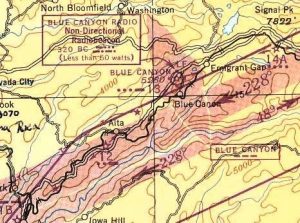by Scott Thompson (illustrations from CAA chart and manual)
Radio Marker Beacons
Radio marker beacons were developed in the late 1920s to provide a means for pilots to specifically mark their locations along an airway or on an instrument approach. Marker beacons were low power transmitters that continuously emitted a distinctive signal. The initial installations of marker beacons were in conjunction with the airway four course ranges. These low power marker beacons transmitted on the same low/medium frequency as the four course range itself. A 1940 CAA training manual noted that “…all radio marker beacons of this type are equipped for two-way voice communications, and are prepared to furnish weather reports and other emergency information, or to report the passage of an airplane, on request. In case the airplane is not equipped with a transmitter, if the pilot circles the marker beacon the operator will come on the air with the weather for that particular airway. The pilot indicates the he has received the information by a series of short blasts of his engine, and proceeds on his way…”
 A later development of the marker beacon utilized a standard UHF frequency of 75 megacycles (later MHz) with an oblong radiation pattern. These became known as fan markers. The sequence of transmitted tones served to identify a specific marker the pilot was overflying, which allowed him or her to know which range course the pilot was flying and also the range from the station. These airway fan markers were also essential in the early
A later development of the marker beacon utilized a standard UHF frequency of 75 megacycles (later MHz) with an oblong radiation pattern. These became known as fan markers. The sequence of transmitted tones served to identify a specific marker the pilot was overflying, which allowed him or her to know which range course the pilot was flying and also the range from the station. These airway fan markers were also essential in the early
days of air traffic control to fix aircraft location.
The UHF fan markers were also integrated into the Instrument Landing System (ILS) as outer, middle, and inner markers and served much the same purpose: fixing aircraft range from, in this case, the runway. For these installations, the markers continuously transmitted a dashed tone (outer marker), a dit-dashed tone (middle marker), or a dit tone (inner marker). In the standard ILS installation, the outer or middle marker was often combined with a non-directional locator beacon to become the LOM (locator outer marker) or LMM (locator middle marker). The NDB portion of the LOM was often essential in pre-radar days to get pilots established on the ILS’s final approach course.
As with many early radio aids, the marker beacons have suffered death from a thousand cuts as the modern FAA has slowly decommissioned all the airway markers and most of the approach marker beacons. Category II and III ILS installations usually still retain an inner marker, but DME has (very) long supplanted the usefulness of marker beacons and they have gone by the wayside. Most legacy Cessnas and Pipers still retain the marker beacon receivers, however. They display colored lights for each of the types of markers: blue for outer marker, amber for middle marker, and white for inner marker or (for really old dudes) an airway fan marker. But, there’s a good chance that a modern instrument pilot has never actually heard the marker beacon receiver emit so much as beep in all of his or her entire instrument flying.
 Here is the Blue Canyon airway fan marker depicted on a 1945 navigation chart. The box in the lower right labeled “Blue Canyon” shows the transmitted tone for the beacon as ‘dash dash dash’ and, as a standard fan marker, transmitted on 75 megacycles. Also located at Blue Canyon was an NDB transmitting on 320 kilocycles with a transmitted identification (“BC” in Morse code) and two-way voice capability with Blue Canyon Radio, an airway radio station.
Here is the Blue Canyon airway fan marker depicted on a 1945 navigation chart. The box in the lower right labeled “Blue Canyon” shows the transmitted tone for the beacon as ‘dash dash dash’ and, as a standard fan marker, transmitted on 75 megacycles. Also located at Blue Canyon was an NDB transmitting on 320 kilocycles with a transmitted identification (“BC” in Morse code) and two-way voice capability with Blue Canyon Radio, an airway radio station.
